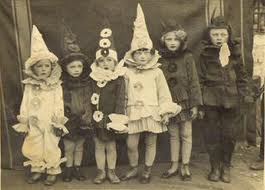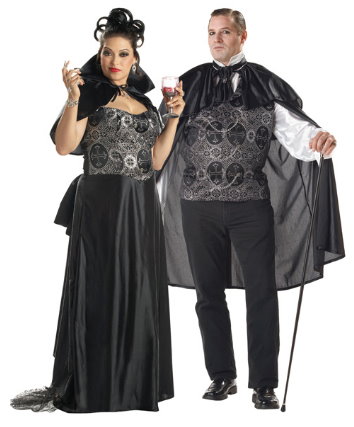Before looking at Victorian Halloween, it’s worth knowing that the origins of Halloween lie in the ancient Celtic holiday of Samhain.
Victorian Halloween history
November 1st was the start of new year for celts. It was a belief that the previous night was a time when the veil between the worlds of the living and the dead were the thinnest. The day before the new year was the day when the spirits of the dead would wander around and that one could communicate easier with them to divine the future.
Halloween was celebrated with bonfires, and parades, with people dressing up as animals or wearing masks, to trick the wandering spirits. Food and a lit candle were also left on doorsteps to feed the visitors from the other side.
There was an attempt later by the church to Christianise the holiday by turning November 1 into All Saints Day and November 2 into All Souls Day. So, instead of leaving food out as offerings to the dead, people were encouraged to give the food to the poor.
A custom was developed which involved giving out small cakes to the poor, called “soul cakes”.
The second half of the 19th century saw many Victorians trying to reduce the creepy or spooky aspects of Halloween and make it more cutesy.
Halloween is a holiday that is celebrated every year on 31st October. On Halloween nights, people celebrated it by dancing, playing games, feasting, telling ghost stories to the friends and family who come together to enjoy this day.

The difference between Halloween and other celebrations is the costume worn. On Halloween nights, people would dress up like supernatural being like vampires, skeleton, witches and devils, etc.

Victorian Halloween
Victorian Halloween parlor games
Play parties were events held to celebrate the harvest, where neighbours would share stories of the dead, tell each other’s fortunes, dance, and sing. Colonial Halloween festivities also involved the telling of ghost stories and mischief-making of all kinds.
In America, in the late 1800s, Halloween was tried as a holiday more about community and neighbourly get-togethers. Later in the century, Halloween parties for both children and adults became the favorite way to celebrate.
Newspapers and community leaders encouraged parents to take anything “frightening” or “grotesque” out of Halloween celebrations. Superstitious and religious overtones were soon replaced. Parties started focusing on games, such as Pin The Tail On The Donkey, Blind Man’s Bluff, Bobbing for Apples, foods of the season, and festive costumes. Then there was scavenger hunt where boys and girls could pair up and search in the dark. Fortune telling, and games to divine your “true love” were popular.
Victorian Halloween party
A popular game was the Halloween pudding. In this game, the host would bake a fruit cake with five objects hidden inside – a ring, a coin, a thimble, a button and a key. At
At 9pm, the oldest person would silently cut the cake and gave the pieces. The first words spoken after the cake was cut would be prophetic for the year. Person getting the piece with the ring would get married that year, the coin would be wealthy, the button meet their love, the key go on a journey, and the thimble be an old maid/bachelor.
Victorian Halloween games
A game involved a single woman going alone into a darkened room with a mirror and a candle. She would take an apple with her and try to peel it all in one piece, or slice the apple. It was believed your true love’s face would appear in the mirror. If you were going to die that year, a skull would appear.
Then there was a game where young women would go one by one into a dark room, which was claimed to be haunted, with a chest of drawers with boxes in them. They would then to go into the room in silence and collect a box from the drawer (which was filled with party favors for the guest) without screaming.